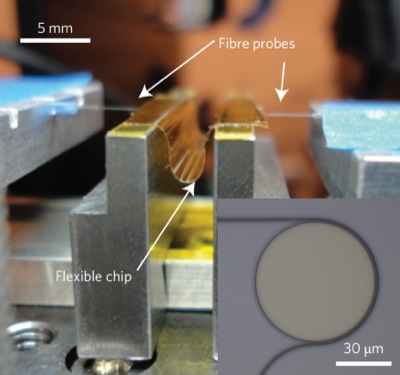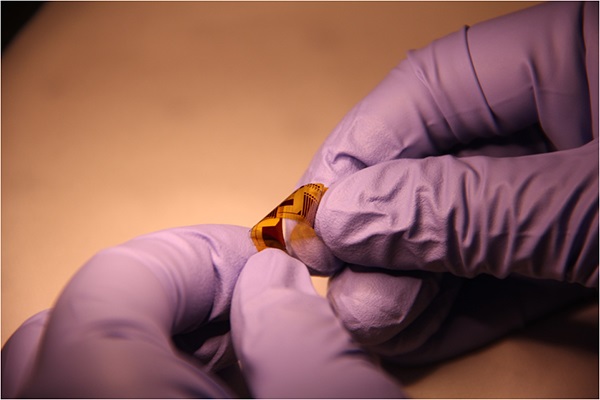Aug. 4, 2014--A team of researchers at the University of Delaware has developed a way to fabricate high-performance flexible optical devices by combining chalcogenide glass and polymers.
Chalcogenide glass is a material commonly used in infrared optics, optical fibers, camera lenses and prisms. While the material is not flexible, it is fully compatible with polymers, which are flexible, allowing it to be processed and made into devices.
“The beauty of this technology is that the chalcogenide glass works with almost any type of polymer, allowing it to be used in many ways,” explains Juejun Hu, assistant professor of materials science and engineering and lead researcher on the project.
Working with colleagues at University of Texas, Austin, and University of Central Florida, Hu’s team developed an innovative design to exploit the fact that polymers naturally tend to deform (or bend) in certain ways, with some areas remaining rigid all the time.
By selectively placing the photonic device, comprised of chalcogenide glass, in the areas of the polymer that will not deform when bent, twisted or rolled, Hu is able to achieve a device with superior flexibility and high optical performance.
“Simply put, our design allows us to make the rigid material do something very flexible,” he said.
In laboratory testing Hu’s device functioned well, even when bent to a radius of one-half millimeter over 5,000 times. The device experienced one of the lowest optical loss on record, almost an order of magnitude less than previous flexible optical devices.
Applications for the work include wearable devices, flexible consumer electronics and foldable portable power generation systems, even sensors that can be integrated on human skin.
For photonics applications, Hu’s device can provide better power efficiency and sensitivity, while making it an attractive option for small photonic devices with cramped or unusually shaped spaces.
It also opens the door for photonics to be used in biomedical applications such as flexible electrodes to measure the electrical activity of the brain during an electroencephalogram (EEG).
The researchers recently reported their findings in Nature Photonics.
Contributing authors on the paper include UD graduate students Lan Li, Hongtaio Lin and Yi Zou, and researchers from the University of Texas, Austin, the University of Central Florida and 4IRradiance Glass Inc.

A team of researchers at the University of Delaware has developed a way to fabricate high-performance flexible optical devices by combining chalcogenide glass and polymers.
Photos and images courtesy of Juejun Hu and by Evan Krape
Hu and his UD research team designed, fabricated and tested the device, while his collaborators created the mechanical model (UT Austin) and the chalcogenide glasses (UCF).
The work is funded through support from the Delaware NASA Experimental Program to Stimulate Competitive Research (EPSCoR), the National Science Foundation and the Cockrell School of Engineering of the University of Texas, Austin.
Article by Karen B. Roberts
Photos and images courtesy of Juejun Hu and by Evan Krape















